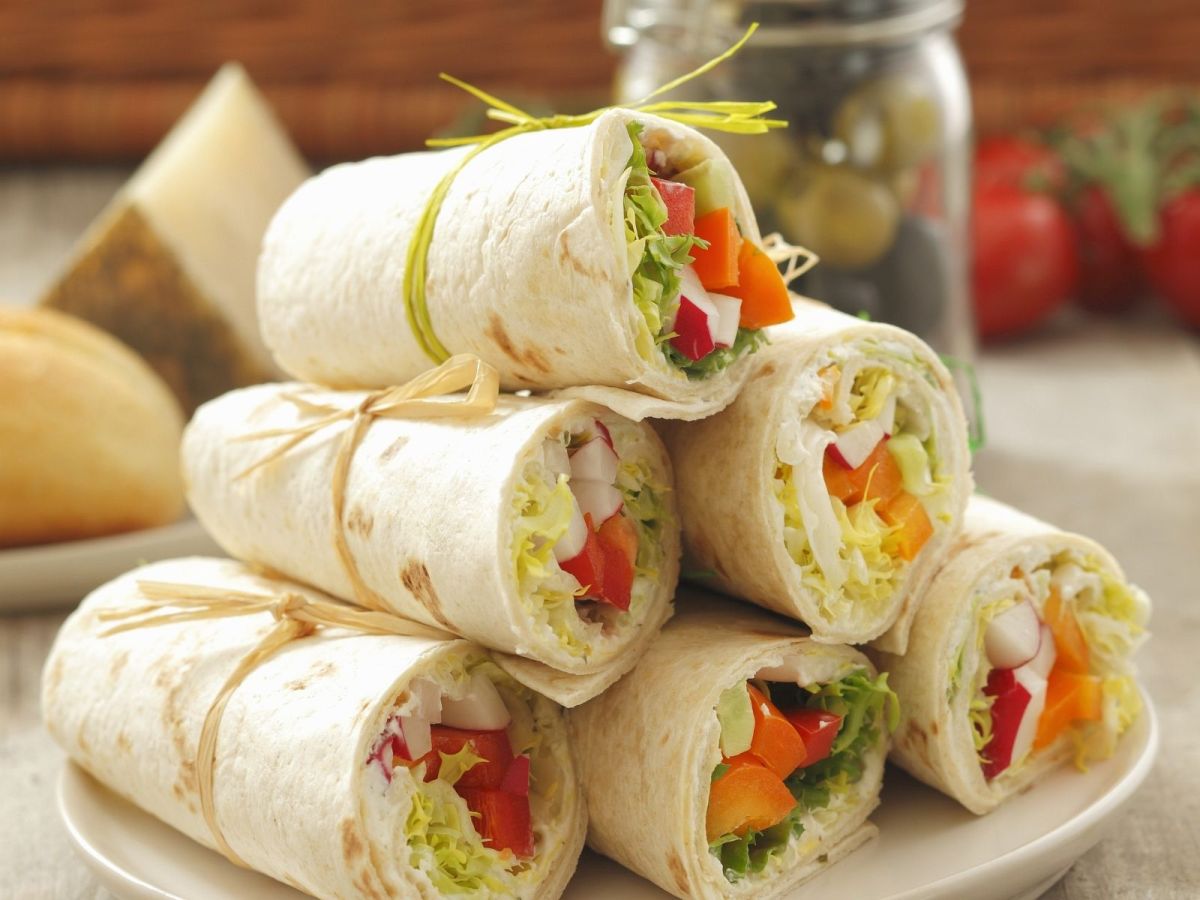Tired of the same old boring vegetarian wraps? Prepare to elevate your lunch game! This guide dives deep into creating vibrant, flavorful vegetarian wraps that are anything but ordinary. We’ll explore a world of exciting filling combinations, from zesty Mediterranean to spicy Mexican, showcasing diverse textures and exciting flavor profiles. Learn how to select the perfect wrap, master the art of warming tortillas to prevent tearing, and discover creative ways to incorporate vegetarian protein sources for a satisfying and nutritious meal.
We’ll guide you through creating three unique sauces and dressings to perfectly complement your chosen fillings, offering detailed recipes and tips for achieving the ideal texture and consistency. Finally, we’ll walk you through a step-by-step recipe for a show-stopping vegetarian wrap, complete with stunning presentation ideas and tips for storage and reheating. Get ready to transform your lunchtime routine!
Flavorful Filling Combinations

Vegetarian wraps offer a fantastic canvas for culinary creativity, allowing for a vibrant array of flavors and textures. The key to a truly satisfying vegetarian wrap lies in thoughtfully combining ingredients to achieve a balanced and exciting taste experience. Below, we explore five distinct filling combinations, each showcasing a unique flavor profile and textural contrast.
Mediterranean Delight
This combination bursts with the bright, fresh flavors of the Mediterranean. Imagine juicy sun-dried tomatoes, their intense sweetness mingling with the salty tang of crumbled feta cheese. A generous helping of Kalamata olives adds a briny depth, while crisp cucumber and spinach provide refreshing counterpoints. A light drizzle of lemon-herb vinaigrette ties everything together, enhancing the overall brightness. The creamy feta contrasts beautifully with the crunchy cucumber and the soft spinach.
Spicy Mexican Fiesta
This vibrant filling evokes the lively spirit of Mexican cuisine. Black beans, seasoned with cumin and chili powder, provide a hearty base, their earthy flavors complemented by the zesty punch of corn salsa. Shredded Monterey Jack cheese adds a creamy, slightly spicy element, while chopped red onion provides a sharp bite. A dollop of guacamole introduces a rich, creamy texture and a subtle avocado flavor. The contrasting textures – the creamy guacamole, the soft beans, and the crunchy corn – create a delightful mouthfeel.
Asian-Inspired Harmony
This filling showcases the delicate balance of Asian flavors. Imagine tender strips of marinated tofu, their subtle soy flavor enhanced by the sweet heat of a sriracha mayo. Shredded carrots and crunchy bell peppers add a vibrant crunch, while fresh cilantro provides a bright, herbaceous note. A sprinkle of toasted sesame seeds adds a nutty aroma and a pleasant textural contrast. The soft tofu contrasts beautifully with the crunchy vegetables and the creamy sriracha mayo.
Italian Garden Freshness
This combination celebrates the simple elegance of Italian flavors. Roasted red peppers, their sweetness intensified by the roasting process, form the base. Creamy ricotta cheese adds a luxurious texture and a subtle tang, while fresh basil provides a fragrant, peppery note. A sprinkle of pine nuts adds a pleasant crunch and a nutty flavor. The soft ricotta contrasts with the slightly firm roasted peppers and the crunchy pine nuts.
Southwestern Sunset
This filling captures the warm, earthy flavors of the American Southwest. Seasoned black beans provide a hearty base, their earthy notes complemented by the smoky flavor of roasted sweet potatoes. Chopped red onion adds a sharp bite, while crumbled cotija cheese lends a salty, crumbly texture. A drizzle of chipotle-lime dressing ties everything together, adding a touch of smoky heat and zesty citrus. The creamy beans and sweet potatoes contrast beautifully with the crunchy red onion and crumbly cotija.
Nutritional Comparison
| Filling Combination | Calories (per serving) | Protein (grams per serving) | Fiber (grams per serving) |
|---|---|---|---|
| Mediterranean Delight | 300 | 15 | 8 |
| Spicy Mexican Fiesta | 350 | 18 | 10 |
| Asian-Inspired Harmony | 280 | 12 | 6 |
| Italian Garden Freshness | 250 | 10 | 5 |
| Southwestern Sunset | 320 | 16 | 9 |
Wrap Selection and Preparation
The foundation of a truly delightful vegetarian wrap lies not just in its vibrant fillings, but also in the careful selection and preparation of the wrap itself. The right wrap can elevate your culinary creation, providing a complementary texture and subtle flavor that enhances the overall dining experience. Choosing the wrong one, however, can lead to a soggy, broken mess. Let’s explore the options and techniques to ensure wrap perfection.
The type of wrap you choose significantly impacts the final product. Different wraps offer distinct textures and flavors, each better suited to certain fillings than others. Consider the weight and moisture content of your filling when making your selection.
Wrap Types and Their Characteristics
Flour tortillas, with their soft, pliable texture and slightly sweet taste, are a classic choice. Their neutral flavor profile allows the vibrant tastes of your fillings to shine through. They’re particularly well-suited to fillings that are not overly wet or heavy. Whole wheat tortillas offer a heartier, more rustic alternative, boasting a slightly nutty flavor and a more robust texture. Their higher fiber content provides a satisfying chew, making them ideal for heartier vegetarian fillings. Lavash, a thin, almost cracker-like flatbread, provides a crisp contrast to softer fillings. Its delicate flavor makes it a versatile option, though its thinness requires careful handling to prevent tearing. Larger wraps, such as burrito-sized flour tortillas, are perfect for substantial fillings, while smaller ones are ideal for lighter combinations or individual servings.
Warming Wraps for Optimal Flexibility
Properly warming your wraps is crucial for achieving optimal flexibility and preventing tears. A slightly warmed wrap is more pliable and less likely to crack under the weight of the filling. There are several effective methods. You can gently heat them in a dry skillet over medium-low heat for about 15-20 seconds per side, watching carefully to avoid burning. Alternatively, you can microwave them wrapped in a damp paper towel for 10-15 seconds. This method adds a touch of moisture, making them even more supple. A third option is to briefly warm them in a low oven (around 250°F or 120°C) for a few minutes. The goal is to achieve warmth and suppleness, not crispness.
Preventing Soggy Wraps and Breakage
To prevent sogginess, it’s essential to avoid overly wet fillings. Drain any excess liquid from ingredients like vegetables or beans before adding them to the wrap. Spreading a thin layer of a creamy element like hummus or avocado near the edges can act as a barrier, preventing moisture from saturating the wrap. Avoid overfilling the wrap; a tightly packed wrap is more likely to break. Instead, layer your fillings carefully and evenly to distribute the weight. Finally, roll the wrap firmly but gently, ensuring all ingredients are securely tucked inside. A slightly overlapping fold at the end will help to secure the wrap and prevent unraveling.
Step-by-Step Recipe and Presentation
This recipe details the creation of a vibrant and flavorful Mediterranean Quinoa Wrap, showcasing a delightful balance of textures and tastes. The step-by-step guide ensures a straightforward process, resulting in a visually appealing and delicious vegetarian meal. The final presentation suggestions elevate the wrap from a simple lunch to a culinary delight.
Mediterranean Quinoa Wrap Recipe
This recipe yields two generously sized wraps.
- Prepare the Quinoa: Rinse one cup of quinoa thoroughly under cold water. Combine the rinsed quinoa with two cups of vegetable broth in a saucepan. Bring to a boil, then reduce heat to low, cover, and simmer for 15 minutes, or until all the liquid is absorbed. Fluff with a fork and set aside to cool.
- Sauté the Vegetables: While the quinoa cooks, finely chop one red bell pepper, half a red onion, and a cup of cherry tomatoes. Heat a tablespoon of olive oil in a large skillet over medium heat. Add the red onion and bell pepper and sauté for 5-7 minutes, until softened. Add the cherry tomatoes and cook for another 2-3 minutes, until slightly softened but still holding their shape. Season with salt and pepper to taste.
- Prepare the Dressing: In a small bowl, whisk together two tablespoons of olive oil, two tablespoons of lemon juice, one teaspoon of dried oregano, half a teaspoon of dried basil, and a pinch of salt and pepper.
- Assemble the Wraps: Lay out two large flour tortillas. Spread a generous layer of the cooled quinoa over each tortilla. Top with the sautéed vegetables, evenly distributing them. Drizzle the lemon-herb dressing over the vegetables and quinoa.
- Add Finishing Touches: Crumble half a cup of feta cheese over the vegetables (optional). Add a handful of fresh spinach leaves to each wrap for added freshness and vibrant green color.
- Roll and Serve: Carefully fold in the sides of the tortillas, then tightly roll them from one end to the other. Cut each wrap in half diagonally for easier handling.
Presentation and Garnishing
The finished Mediterranean Quinoa Wrap presents a visually stunning array of colors and textures. The vibrant red of the bell peppers and tomatoes contrasts beautifully with the earthy tones of the quinoa and the creamy white of the feta cheese (if used). The bright green of the spinach adds a refreshing touch. The wrap itself should be tightly rolled, showcasing its layered filling.
For an enhanced presentation, consider serving the wraps on a bed of fresh arugula. A sprinkle of extra oregano or a drizzle of additional lemon-herb dressing adds a final touch of visual appeal and flavor. The slightly warm vegetables and cool quinoa offer a delightful textural contrast, creating a satisfying mouthfeel.
Storage and Reheating
Leftover wraps can be stored in an airtight container in the refrigerator for up to three days. To reheat, gently wrap the wrap in a damp paper towel and microwave for 30-60 seconds, or until heated through. Alternatively, you can gently reheat them in a skillet over medium-low heat for a crispier tortilla. Reheating methods should aim to maintain the freshness of the vegetables and the texture of the quinoa, avoiding overcooking.
From selecting the perfect wrap and mastering the art of preventing sogginess to creating flavorful fillings and stunning presentations, this guide empowers you to craft vegetarian wraps that are bursting with taste and visual appeal. With a range of protein sources, diverse flavor combinations, and delectable sauces, your culinary creativity will know no bounds. So, ditch the boring wraps and embrace the exciting world of flavorful, satisfying vegetarian cuisine. Your taste buds (and your lunchbox) will thank you!
Top FAQs
Can I make the wraps ahead of time?
Yes! Assembled wraps can be stored in the refrigerator for up to 2 days. Reheat gently in a pan or microwave before serving.
What if my tortillas tear easily?
Gently warm your tortillas in a dry pan or microwave for a few seconds to increase their flexibility and prevent tearing. Avoid over-warming.
Are there gluten-free wrap options?
Absolutely! Look for gluten-free tortillas made from corn, rice, or other gluten-free flours. Many brands offer these options.
How can I add more vegetables to my wraps?
Experiment with various vegetables like shredded carrots, bell peppers, spinach, cucumbers, or roasted vegetables for added crunch and nutrients.


